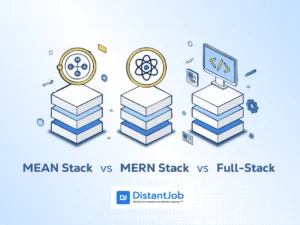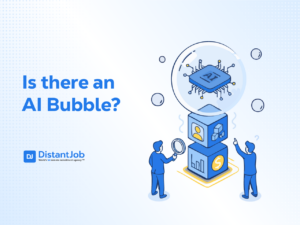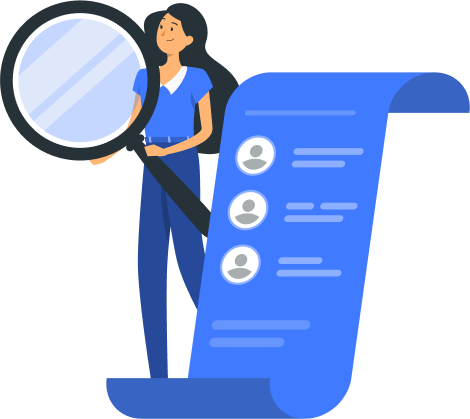Application Engineers are the bridge between engineers and customers. Where developers receive a specification and start building, AEs often must discover what must be built. They understand the user experience, environment, and challenges, and convert vague business requirements into technical requirements.
It’s wrong to assume their work is internal development or customer tech support. Instead, it’s all about knowing specific end-user needs and actively designing new features to meet their desires.
Let’s tackle all that entails being an application engineer, from definitions, roles, salary, and everything you need to know!
What Is an Application Engineer?
An Application Engineer is a professional who improves and adapts a service or a product to fit a specific customer, market, or need. They support the product team, software engineers, and customers to make sure that the product matches the customers’ requirements and can operate in the client’s environment.
However, that doesn’t make them a Product Manager or a Product Owner. Although an AE must understand the customer’s needs, their scope is technical. They need to collect requirements to turn them into reality.
An Application Engineer isn’t a software engineer, even if both have coding skills. A software engineer designs and builds systems, while an application engineer focuses less on systems and architecture and more on the client side.
They aren’t also directly involved with sales support – that’s the job of another professional, called a Field Application Engineer. While an application engineer often hears feedback from the sales team, they are not always “in the [sales] field”, but are daily working alongside developers. Despite similar names and functions, they have completely different roles.
Of course, expect different companies to have different approaches; their roles might overlap.
Typical Responsibilities of an Application Developer
An application developer has several responsibilities :
Technical Consultation
Senior App engineers work closely with their clients and stakeholders to understand their needs and translate them into functional and technical requirements. They also recommend customized solutions. An application engineer has a client-first vision of the whole project.
System Integration
They ensure that technology products work in customers’ devices. Nothing frustrates a client more than buying a program just to learn it doesn’t work in their operating system. They modify software or hardware components to better fit client-specific requirements.
They work closely with marketing, engineering, and product development teams to deliver optimal client (public or stakeholders) outcomes. They are aligned with marketing, design, and sometimes sales.
Documentation
Application engineers create detailed documentation for customized solutions, integrations, and troubleshooting guides. They take note of all systems, hardware components, software installed, and how they work in different OS and platforms. They also have a list of known issues and bugs to keep both their clients and the devs aware.
Industries that employ AE include: manufacturing, software solutions, electronics, industrial equipment, automotive, healthcare technology, and automation.
Essential Skills and Educational Qualifications
Technical Skills:
- Proficiency in programming languages relevant to the specific industry (e.g., Python, Java, C++, .NET, JavaScript, PLC programming).
- Knowledge of software systems, development lifecycles, hardware components, networks, and integration techniques.
- Testing and Quality Assurance
- Familiarity with database management and data-driven applications.
Soft Skills:
- Strong communication and interpersonal skills for client interactions.
- Problem-solving abilities to address customer-specific technical challenges.
- Collaborative mindset, enabling seamless interaction with diverse internal and external stakeholders.
Application Engineer vs. Related Roles
Application Engineers are often confused with other types of engineers. Here’s a table of comparison between an application engineer, a software engineer, and a field application engineer.
| Aspect | Application Engineer (AE) | Software Engineer (SE) | Field Application Engineer (FAE) |
| Primary Focus | Customising or integrating software to solve specific user/business problems and deliver user-friendly apps | Designing and building the core systems, frameworks, and algorithms that power software products | Pre-sales and post-sales technical support; on-site implementation to ensure customers succeed with complex products |
| Key Responsibilities | Gather client requirements Design / develop bespoke features Integrate existing components Test, deploy, and support solutions | High–frequency stakeholder meetings | Architect and program foundational systems. Design & optimise algorithms. Write, test, and maintain codebases. Define software design patterns |
| Typical Skill Emphasis | Solution customisation, integration, problem-solving in a business context, UX awareness, strong communication | Deep programming, data structures, system design, performance optimisation, software architecture | Technical persuasion, product expertise, project management, presentation & relationship-building, rapid on-site problem-solving |
| Level of Direct Client Interaction | High–frequency stakeholder meetings | Low → Medium – usually indirect or via product managers | Very High – often embedded at customer sites |
| Typical Starting Point | An existing application or a clearly defined client pain point | A new system or product built largely from scratch | A customer need within the sales cycle requires a tailored solution |
A. Application Engineer vs. Software Engineer
The primary distinction between an Application Engineer (AE) and a Software Engineer (SE) is that an AE tends to concentrate on understanding specific user or client requirements and then crafting user-friendly software applications. Their work frequently involves integrating existing software components or adapting current technologies. In contrast, Software Engineers are more commonly responsible for designing and building the underlying systems, frameworks, and core architecture that power software applications, often starting projects from the ground up.
Their focus is heavily on programming, algorithm design, and software design patterns — all the systems behind a service or an application. In short, application engineers create solutions for users; software engineers build software’s backbones.
B. Application Engineer vs. Field Application Engineer (FAE)
Field Application Engineers (FAEs) and Application Engineers are technical and client-facing, but their roles vary. The FAE role typically carries a more pronounced emphasis on pre- and post-sales technical support. They engage in direct customer engagement and ensure the successful implementation of products. An AE is more like a bridge between the developer team and the customer.
Educational Background
Application Engineers hold a bachelor’s degree in Engineering (Mechanical, Electrical, Software, or Systems Engineering), Computer Science, Information Technology, or related fields. Specialized industry certifications or training are often beneficial for career advancement.
Salary Expectations in the U.S.
In the United States, an AE has competitive salaries, reflecting their specialized expertise and the direct value they provide to clients:
- Entry-level Application Engineers: Generally start with salaries ranging from $65,000 to $85,000 annually.
- Mid-level Engineers: Salaries typically range from $85,000 to $110,000 per year.
- Experienced Senior-level Engineers: Often command salaries from $110,000 to over $140,000 annually, with variations based on the industry, location, and company size.
Industries such as manufacturing, automotive, and specialized software solutions often offer higher compensation due to the critical nature of these roles in customer retention and satisfaction.
Conclusion
The Application Engineer role is one of the fastest-growing and most exciting positions in the high-tech world. They translate customers’ needs into relevant software, everything a company needs to turn clients into a loyal customer base. With average salaries ranging from $85,000 to over $150,000 a year, and job growth expected to continue through 2030, this is a financially lucrative and highly stimulating career.
Whether you’re a specialized developer looking for a job as an AE or you’re a hiring manager looking to hire one, we can help. Book a free consultation today to learn more.





